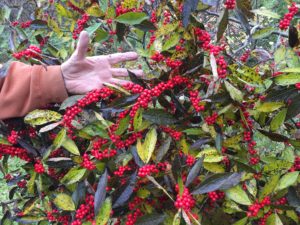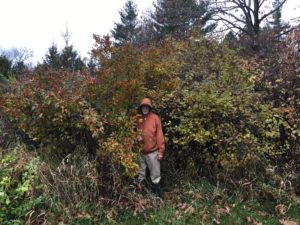Winterberry: An Attractive and Useful Native
The East Coast has about a dozen species of holly, most of them evergreen, with pointy leaves and red berries, like you see portrayed on holiday cards and wrapping paper. But in the Midwest, the field narrows to a few deciduous species, dominated by possumhaw in the south and winterberry in the north.

Closeup of typical large yield of berries.
Winterberry is a common wetland shrub in Wisconsin and east-central Minnesota, and it extended at least as far south as Linn County Iowa, where it was still growing in the 1970s. I experimented with propagating that local ecotype from both seed and stem cuttings and was unsuccessful. However, nurserymen and women had already been making selections from the wild, and there were already many named clones available.
Because our homestead management favors wildlife, I chose the female variety named “Winter Red,” which was selected as a large shrub producing abundant bright red berries.

An unsupported Winter Red sagging under abundant fruit.
Winterberry needs one male consort for about every half dozen females, and he needs to bloom at the same time as the girls. I chose Southern Gentleman, which is equally large and quite floriferous.
In recent years the retail nurseries now tend to offer smaller-sized selections, more suitable for raingardens, patios, and house foundation plantings.
In years of heavy fruiting of Winter Red, the weight pulls the stems nearly to the ground if the plant is grown in the open, unsupported.

Winterberry in our birdberry thicket. (2947) Winter Red upright on the left, her consort Southern Gentleman on the right – without berries.
By contrast, if Winter Red or other heavy bearers are planted in a wildlife thicket and mixed with other shrubs, they support each other. Wild vines also weave them together for mutual support.
According to Haliveg (1974), winterberry fruits are “…eaten by various small mammals and more than 48 species of birds.” In spite of their attractiveness to us, the berries are not edible to humans. My birds will often ignore them until sometime in December when snow has covered their ground-level food supply, and then swoop in and strip the bushes within a few days.

Winter Red contrasting with the snow.
In a bygone era, people cut holly branches laden with fruit for household holiday decorations – “deck the halls with boughs of holly….” But in the modern era our overheated homes too quickly dry them out, and today winterberry is better reserved for outdoor decorations.
So whether you have a little raingarden in town, or an acreage with wetlands in the country, there are perhaps a hundred named selections of different versions of the species. Catalogues also offer seedlings grown from wild seed and one cannot predict exactly what they will grow into.
Incidentally, the preceding photos were taken near the end of the growing season. By Thanksgiving they have shed their leaves, which briefly turn brown or black, leaving the fruit better exposed. They are showier if partially covered with snow for contrast.
Tags: Lon Drake, native habitat, winterberry

